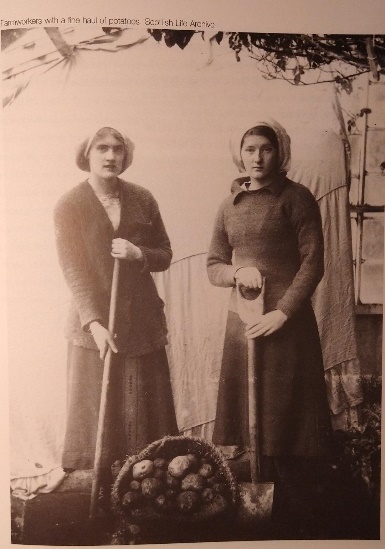
By Carolyn McDonald Graf
Cottage pie, as the name suggests, is a pie of humble origins. Using simple ingredients of vegetables and meat with potatoes as a topping, it is very similar to Shepherd’s pie. The difference is the type of meat. Shepherd’s pie, as the name suggests, traditionally contains lamb, while cottage pie uses beef. The use of potatoes in Scotland is an interesting topic which has been covered here before, but I am including it again for reference.
Potatoes originated in the Andes of South America. The cultivation of potatoes may go back 10,000 years, but they don’t preserve well so it is difficult for archaeologists to prove this. The earliest remains have been found in coastal Peru dating to 2500 BC. Potatoes are found as designs on pottery vessels which may indicate their importance and perhaps storage.
These South Americans prepared their potatoes much the same as modern methods by mashing, boiling, roasting, and stewing. Other methods involved letting them freeze several times and then squeezing out the liquid, creating a lighter, dry product. This became chuno and was the major cash crop of the Andean Indians. Its advantages included longevity and its usefulness to armies and travelers. The Spanish fed chuno to the silvermine workers who created great wealth for the Spanish government.
The cultivation of potatoes spread around the world through various trade routes. It arrived in Europe sometime before the end of the 16th century by two different ports of entry: the first in Spain around 1570, and the second via the British Isles between 1588 and 1593.
They were first eaten in the homes of wealthy Scots in the 1600s. There are records of a few potato gardens in Edinburgh in 1725 and were first cultivated in Stirling in 1739. Potatoes were not known in the Highlands and Islands before 1743 and were shunned by crofters and farmers. The Ministers of the Kirk encouraged this as potatoes were not mentioned in the bible.
There is a story that the islanders of Skye were forced to grow potatoes by the MacDonald Chieftain. They grew them and then dumped them all on his doorstep saying “ye can force us to grow them but ye canna force us into the sin of eating them”. Gradually, potatoes were accepted and became a major staple. They grew well in the rocky soils, stored well, and were filling.
Then, in 1845, the blight came. Due to the lack of genetic diversity, the blight spread rapidly. The following year, the crop failed completely. Famine spread through the Highlands, the Hebrides, Orkney and Shetland. It could have caused devastation equal to that seen in Ireland, but aid was given by landowners, the Free Church and, eventually, the government.
Economically the potato is credited with expanding the industrial revolution. It was a cheap source of nutrients and was easily grown in small plots tended in the cities by factory laborers. In the coal areas, the added nutrients and calories created a population increase that created workers for that industry.
The creation of blight resistant potato varieties in the 1900’s again put potatoes back on tables. The invention of French fries and potato chips has added to the modern success of the potato industry. Cottage Pie is among the many ways Scots enjoy potatoes today.
Here’s a version of Cottage pie from Coinneach MacLeod’s newest cookbook, The Hebridean Baker At Home. As with so many of his recipes, he takes a traditional one and gives it a new twist. His latest cookbook includes Atholl Brose Cheesecake, Salmon Burgers, And Salmon Wellington encased in pastry. His Cottage Pie recipe uses a baked potato for the crust and cheese mixed into the mashed potatoes for the topping.
Baked Potato Cottage Pie
Ingredients
6 large baked potatoes
2 ½ ounces of butter (2 ½ tablespoons)
½ cup double cream (or heavy cream)
3 ½ ounces of Cheddar, grated
Oil to bake the potatoes
Salt and pepper to taste
For the cottage pie filling
1 large onion, chopped
2 sticks celery, chopped
1 lb 6½oz beef mince (ground beef)
2 tablespoons tomato puree
Splash of Worcestershire sauce
1 Tablespoon of plain flour
½ cup +2 tablespoons red wine
4 sprigs fresh thyme leaves only
1 2/3 cup beef stock
Olive oil for frying
Salt and pepper

Method
Preheat oven to 375°. Rub a little oil and seasoning over the potatoes, then bake on a baking sheet for 60 to 75 minutes until the flesh is tender and the skin crisp and golden.
Meanwhile, make the filling. Add the onion and celery to some olive oil in a large pan and cook until softened.
In another pan, cook the beef until browned. Stir the beef into the onion and celery when ready. Add the tomato puree and Worcestershire sauce and cook for one minute. Stir in the flour and cook or a further minute. Pour in the red wine and add the thyme leaves. Add the stock and simmer for an hour until the mixture has thickened. You can also make this ahead of time and warm before assembling.
When the potatoes are cooked and cool enough to handle, slice a thin portion off the top of each potato. Carefully scoop out most of the inside of each potato and transfer to a bowl. Add the butter and cream to the potatoes in the bowl, then mash well. Stir in the cheese until well combined. Season with salt and pepper to taste.
Keep the oven at 375°. Place the hollowed out potatoes on a baking sheet and fill each potato to the brim with the beef. Now, top each one with a scoop of mashed potato. Bake for 10 to 12 minutes until the cheese has melted and the potato topping is slightly browned.
https://blog.historicenvironment.scot/2017/12/scottish-food-history/
https://en.wikipedia.org/wiki/History_of_the_potato
The Hebridean Baker At Home, Coinneach Macleod, Black & White Publishing, United Kingdom, 2023, p. 195

